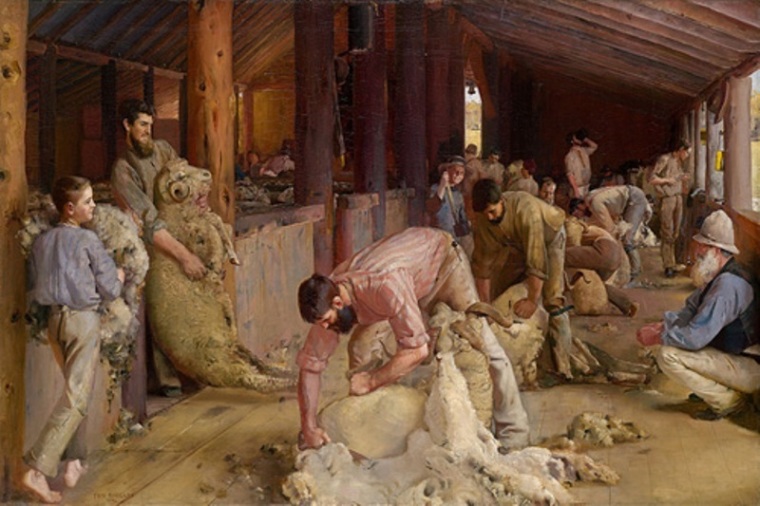
It has been said Australia rode on the sheep’s back.
Well, in economic terms, this statement is correct for the most part up until perhaps the 1960s when our other exports took the lead.
The Australian wool industry has been through some good times, especially after World War II when greasy (just shorn and unwashed) wool sold for “a pound a pound” (approximately $2 for 500gm of wool) in a time when $5 bought enough groceries for a large family for a week.
Money Managers – Not!
My grandparents had never seen so much money as they did in 1951. They renovated the old homestead, they purchased their first truck, their first tractor and then a larger one, a new car, a brand new 24-disc plough and on it went.
(My grandfather died in 1979, $40,000 in debt).
Wool disasters
The Australian wool industry has also been through any number of disasters, the first was probably the 1880s when wool lost all value and sheep were being boiled down for their fat which was worth more than their wool.
Since the 1960s, the prices paid for wool has been like the rolling waves of the sea. One up, one down, repeated over and over. In the late 1960s, wool reached such a low price the government decided to step in to assist the industry which they felt would soon rebound.
The Wool Reserve Price Scheme
The Wool Reserve Price Scheme started in the 1970s and lasted until 2001.
For those who don’t know about this scheme, the Australian Government put in place a ‘floor price’ on wool. This meant anytime the price dropped below the reserve price, wool producers would be paid the reserve price and if the market rose, producers received the market price. It was a safety net which worked well for 20 years while the market price fared well.
Wool producers were overjoyed by this guarantee and started producing even more wool. New producers entered the market and it wasn’t long before supply exceeded demand and the surplus wool was being bought by the government, through the Australian Wool Corporation (AWC) at the reserve price.
Now the AWC seemed to lose the ‘plot’ in the late 1980s by increasing the ‘floor price’ instead of lowering it to what the market was willing to pay. They kept on buying so, in February 1991, there were 4.7 million bales of wool in storage.
Wool prices were so low the AWC decided to sell this wool for whatever they could get for it and at the same time, ceased buying from producers.
Potholes filled with wool
There was so much wool on the market it was selling for less than the cost of production and many producers, trying to compete against the AWC, were bankrupted and millions of sheep were either shot on-property or sold for almost nothing.
I remember seeing a yard of about 150 sheep sold when the auctioneer said he’d take an ice-cream for the pen and someone walked to the canteen and bought him one – it was a hot day after all.
One government scheme had men working on gravel roads filling potholes with unsaleable wool.
Farm economy and sheep numbers
The family farm which supported five families during the 1950s now barely supports my cousin and his wife.
Wool prices today continue to fluctuate and producers celebrate in the good times and battle through the tough times but no longer are they known as the ‘silvertails’ they once were.
“I’m no economist but it gets me riled up when politicians make economic decisions without abiding by basic economic rules.”
In Queensland in 1980, there were approximately 22 million sheep. Although the number is increasing at present because of exclusion fencing (keeping feral dogs out) there are only four million sheep.
Our fine merino wool is still a valuable export commodity and will continue to be for some time into the future but Australia no longer ‘rides on the sheep’s back.’
Life for most of us has its ups and downs and the recent pandemic is an example where good honest workers found themselves unemployed through no fault of their own.
These ‘downs’ have happened before – the Great Depression is another example along with the Global Financial Crash - and similar crises may happen again so what are we to do about it?
Depend on the government for handouts? Not likely.
This reminds me of the chorus of an old hymn I haven’t heard for years, I hope I have the words right.
“Turn your eyes upon Jesus,
Look full in His wonderful face,
And the things of earth will grow strangely dim,
In the light of His glory and grace.”

John Skinner served as an infantry soldier in Vietnam then the Tasmanian Police before taking up the position of CEO of the Australian Rough Riders Association (professional rodeo based in Warwick Qld). Before retirement to his small farm, he was a photo-journalist for 25 years. He is married with 3 children and 7 grandchildren.